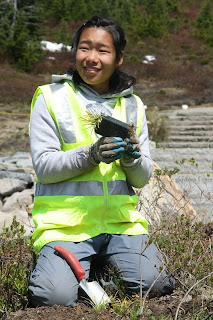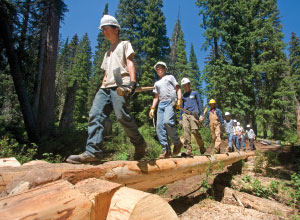 The goal: Nearly $350,000 for parks The News Tribune
The goal: Nearly $350,000 for parks The News Tribune
Washington's National Park Fund seeks to raise $350,000 to support projects at Mount Rainier, North Cascades, and Olympic National Parks, including youth programs, outreach, and volunteerism. For the person who has everything, consider supporting a good cause on their behalf!
Monday, November 30, 2009
The goal: Nearly $350,000 for parks
Friday, November 20, 2009
Investing in communities and long-term stewardship
 In 2008, Washington’s National Park Fund raised $50,000 to support flood recovery and volunteerism at Mount Rainier National Park. This summer, those funds were used to support three teams of high school volunteers through the Student Conservation Association’s Conservation Leadership Corps. Some of the funding also allowed us to hire a six-month SCA intern, Nick Abel, who served at the program’s right hand man throughout the busy summer season.
In 2008, Washington’s National Park Fund raised $50,000 to support flood recovery and volunteerism at Mount Rainier National Park. This summer, those funds were used to support three teams of high school volunteers through the Student Conservation Association’s Conservation Leadership Corps. Some of the funding also allowed us to hire a six-month SCA intern, Nick Abel, who served at the program’s right hand man throughout the busy summer season.
Mount Rainier’s partnership with SCA has been a long and productive one. Interns have served here for more than forty years, and the Conservation Leadership Corps (CLCs) have been an important part of our volunteer program in recent years. Seattle’s CLC recruits make up a diverse cross-section of students from the city and its surrounding communities. Some serve intermittently on projects near home, venturing out to the Mountain only for special events like National Public Lands Day. Others—the ones funded by the grant from the Fund—serve on 15-day full-time work crews, living and working as a team at Mount Rainier National Park, usually in groups of six to eight with a pair of crew leaders.
 This year’s crews served throughout July and August. The first served with our revegetation program at Paradise, landscaping native plants in the construction footprint around the new Jackson Visitor Center. Over the course of 11 work days, each crew member planted more than a thousand plants, representing 25 different native species.
This year’s crews served throughout July and August. The first served with our revegetation program at Paradise, landscaping native plants in the construction footprint around the new Jackson Visitor Center. Over the course of 11 work days, each crew member planted more than a thousand plants, representing 25 different native species.
 The second CLC team worked with our trail crew. Most of their work was along the South Puyallup Trail, filling in about a thousand feet of washed-out trail. They cut back overgrown brush, cleaned drains, and performed general maintenance along the St. George and Goat Lake Trails.
The second CLC team worked with our trail crew. Most of their work was along the South Puyallup Trail, filling in about a thousand feet of washed-out trail. They cut back overgrown brush, cleaned drains, and performed general maintenance along the St. George and Goat Lake Trails.
Team number three completed the work begun by team two along the South Puyallup Trail. They installed seven rock check-steps and two drainage turnpikes. On the North Puyallup Trail, the crew performed general maintenance including brushing 600 feet of trail. They twice hauled decking three miles into the backcountry for use by NPS trail crews.

The statistics are impressive: yards of trail built and repaired, miles walked, plants planted. More important, in the long run, are the experiences of the program’s participants. For two weeks, they practice new skills, contribute to the stewardship of their national park, and learn leadership. Many of these students return for more, serving on other crews or in other internship positions. Many are eventually hired as students to seasonal positions in the parks, and some go on to pursue careers. A significant number of today’s career National Park Service rangers began as volunteers, as I did, or as interns through the Student Conservation Association, as did our own Chief of Interpretation and Education, Lee Taylor. Three years ago, one of the first Flood Recovery CLC interns was Jaya Ghosh, who went on to serve in leadership positions with SCA and this summer worked as a ranger at North Cascades. The CLC program opens doors for a diverse group of young people, and we are proud to be part of it.
We hope that CLC crews will be at Mount Rainier again in 2010. We are in the process of writing grants to support their return.
In addition to the three CLC crews, the Fund’s grant also allowed us to hire Nick Abel, a college student from Sammamish, Washington, who helped manage our volunteer program through the busy summer months of May through October. His support was invaluable. This year, for the first time in three years, we did not have a “Flood Recovery Corps” in the park, helping us to recruit volunteers and lead volunteer projects. Instead, we hired three interns to work within the plant ecology, citizen science, and trails programs to help work with volunteers, and we hired Nick to help oversee the program.
 Nick came to our program without any experience in volunteer program management—but he learned rapidly, and was soon fielding questions and making decisions like a pro. By the end of summer, he was creating volunteer projects on his own and shepherding volunteers and volunteer groups into them. Groups like REI Adventures, Pathfinder Middle School, MEAD Alternative High School, and others came to the park to help with revegetation, trail maintenance, and campground restoration projects. On National Public Lands Day, 223 people helped with projects parkwide. Continuing the good work of the Recovery Corps before him, Nick helped raise the number of volunteers who worked in the park this year from 1,837 to 1,865, and the total number of hours they contributed from 70,130 to 72,231, including the hours invested by three CLC crews.
Nick came to our program without any experience in volunteer program management—but he learned rapidly, and was soon fielding questions and making decisions like a pro. By the end of summer, he was creating volunteer projects on his own and shepherding volunteers and volunteer groups into them. Groups like REI Adventures, Pathfinder Middle School, MEAD Alternative High School, and others came to the park to help with revegetation, trail maintenance, and campground restoration projects. On National Public Lands Day, 223 people helped with projects parkwide. Continuing the good work of the Recovery Corps before him, Nick helped raise the number of volunteers who worked in the park this year from 1,837 to 1,865, and the total number of hours they contributed from 70,130 to 72,231, including the hours invested by three CLC crews.
All told, this is a volunteer effort financially worth more than $1.4 million, and that doesn’t count the long-term influence our programs have had in the lives of the young people involved. Not a bad return on an investment of $50,000, and to those who contributed through Washington’s National Park Fund, we say thank you!
The Fund continues to raise support for projects at all of Washington’s National Parks, including Mount Rainier, North Cascades, and Olympics. They’ve dedicated $18,800 to continue our practice of hiring SCA interns to help recruit, train, and lead volunteers in programs throughout the park. They’re raising money to support the continuation of our Camping Adventure with My Parents urban outreach program. They just accepted $75,000 from Boeing to support energy efficiency and green transportation initiatives at Mount Rainier. And there are many other good projects in their catalog, too. We thank the Fund for their support, and to all who help by contributing, we thank you as well.
Monday, November 16, 2009
Tweet!
FYI, we're now on Twitter! Follow our Twitter feed in the right-hand column, or sign up to receive our tweets directly! (Was that less than 140 characters?)
Scouting leadership group discusses possible major partnership in 2011
This is not an unprecedented possibility. The group last year organized five projects on five different national forests, called "ArrowCorps5." All told, it was the largest organized service project in Forest Service history, contributing a staggering 280,000 work hours nationwide. (A great video about this effort is available online as a 93mb download.)
 Obviously, our piece of that legacy would be smaller. But through partnerships with groups like the Washington Trails Association, by expanding the program beyond park boundaries into adjacent national forest land, and by focusing on trail work as only one of many possible projects, the contribution to Mount Rainier could be significant to say the least.
Obviously, our piece of that legacy would be smaller. But through partnerships with groups like the Washington Trails Association, by expanding the program beyond park boundaries into adjacent national forest land, and by focusing on trail work as only one of many possible projects, the contribution to Mount Rainier could be significant to say the least.We'll spend the next year looking for grant opportunities to support this effort, developing our partnerships, and planning service projects. Stay tuned.
For more information about the next generation of ArrowCorps5, visit their website at www.tkopekwiskwis.org/arrowcorps502 or contact Bob Davies at the Boy Scouts' Chief Seattle Council #609.
Digging for answers at Mount Rainier
 The News Tribune this weekend reports on some remarkable archeological discoveries at Mount Rainier and North Cascades National Parks.
The News Tribune this weekend reports on some remarkable archeological discoveries at Mount Rainier and North Cascades National Parks.
A dig near Cascade Pass in North Cascades National Park has revealed evidence that humans used the area 9,600 years ago. At Mount Rainier National Park, a site on the northern slope of the mountain has produced artifacts dating back 7,600 years.
Thursday, November 12, 2009
Volunteers needed November 15 near north entrance
There aren't many opportunities to volunteer in Mount Rainier National Park this time of year, as snow is rapidly accumulating and roads are closing for the winter. But that doesn't mean there aren't good opportunities nearby! Here's a late-breaking need on Forest Service land just north of the park (forwarded verbatim):
Volunteers Needed Nov 15 - Orchard fence
I'm looking for a handful of volunteers who can help set 165 fence posts in our Forest Service seed orchard located off of SR410 between Enumclaw and Mt. Rainier Nat. Park. The workday is this coming Sunday, Nov 15.
The new fence line will eventually help expose more graze and browse to deer and elk that winter in the White River basin. We will only be setting posts. The fencing material will be moved from the old location to the new location next spring. . The orchard gate will be open at 8 am. Folks can let them selves in. I will have someone at the orchard office to give directions to the work site. This is short notice, but I didn't know when my contractor would complete the digging until last week. The orchard compound is equipped with a toilet and shelter, if needed, to get respite from inclement weather. Workers should bring good rain gear, boots, gloves, food and drink, and their favorite shovel.
After COB today, I will be out of the office until next Monday. But prospective volunteers can call me at: 253-678-7068 for more information and directions to the orchard. My contact email is: asonnypaz@hotmail.com.
~~~~~~~~~~~~~~~~~~~~~~~~~~~~~~~~~~
A. SONNY PAZ
Wildlife Biologist
office: 425-888-1421x221
spaz@fs.fed.us
~~~~~~~~~~~~~~~~~~~~~~~~~~~~~~~~~~

